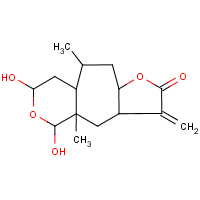Hymenovin
Agent Name
Hymenovin
CAS Number
57074-51-8
Formula
C15-H22-O5
Major Category
Biological Agents

Synonyms
5,7-Dihydroxy-4a,9-dimethyl-3-methylenedecahydrofuro(2',3':5,6)cyclohepta(1,2-c)pyran-2(3H)-one; Furo(2',3':5,6)cyclohepta(1,2-c)pyran-2(3H)-one, decahydro-5,7-dihydroxy-4a,9-dimethyl-3-methylene-; [ChemIDplus]
Category
Plant Toxins
Sources/Uses
Toxic component of the poisonous range plant Hymenoxys odorate; [ChemIDplus] A sesquiterpene lactone; Also found in 2 poisonous range plants: Hymenoxys richardsonii (Pingue) and Dugaldia hoopesii (orang sneezeweed); A major constituent of western bitterweed (Hymenoxys odorata DC); [HSDB]
Comments
Oral LD50 (mouse) = 150 mg/kg; [RTECS] Lethal to sheep at doses of 100 mg/kg; Toxic action may be due to alkylating sulfhydryl groups of enzymes in the body; Emergency treatment: "Plants- sesquiterpene lactones"; Sesquiterpene lactones are in many plants. They cause toxicity mainly in livestock that eat the plants. Human poisoning cases are extremely rare. Possible symptoms after ingestion include irritation of mucous membranes, dyspnea, pulmonary hemorrhage, tremors, seizures, abdominal pain, and liver injury. [HSDB] Sesquiterpene lactones are a common cause of allergic dermatitis in florists. See "Sesquiterpene lactones."
Biomedical References
Adverse Effects
Skin Sensitizer
Yes
Neurotoxin
Other CNS neurotoxin
Hepatotoxin
Hepatoxic (a) from occupational exposure (secondary effect) or (b) in animal studies or in humans after ingestion
Diseases, Processes, and Activities Linked to This Agent
Diseases
Occupational diseases associated with exposure to this agent: